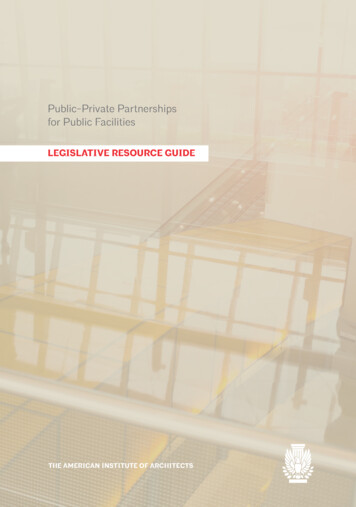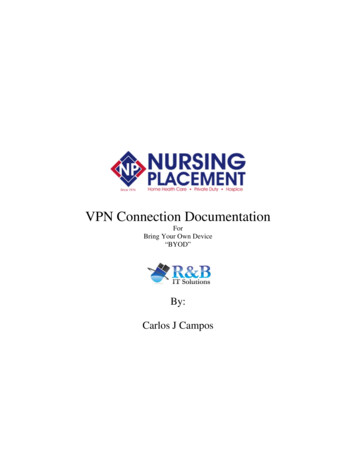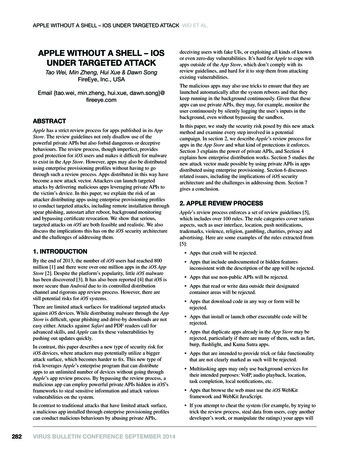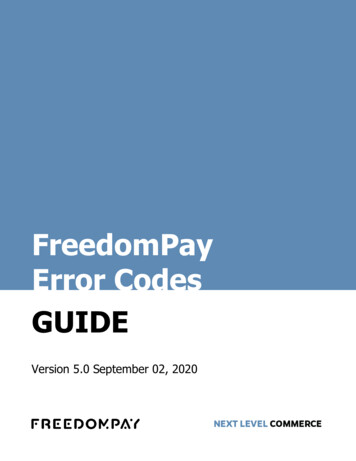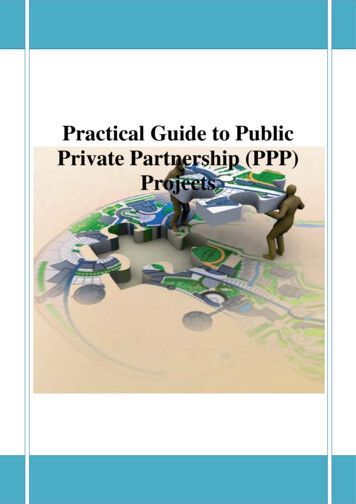
Transcription
Practical Guide to PublicPrivate Partnership (PPP)Projects
ii
iiiPractical Guide to Public Private Partnership (PPP)Projects
ivPublished by the Hong Kong Institute of SurveyorsSuite 801, 8/F., Jardine House,1 Connaught Place,Central,Hong KongTelephone:852 2526 3679Facsimile:852 2868 4612E-mail:info@hkis.org.hkWeb Site:www.hkis.org.hkPrinted in Hong Kong SAR, ChinaCopyrightThe copyright of this publication is owned by the Hong Kong Institute of Surveyors.All rights reserved; no part of this publication may be reproduced, stored in anyretrieval system, or transmitted in any form or by any means, electronic, mechanical,photocopying, recording, or otherwise without either the prior written permission ofthe Hong Kong Institute of Surveyors.First published 2009DisclaimerWhile this publication is partly funded by the Commerce, Industry and TechnologyBureau, the Government of the HKSAR under the Professional ServicesDevelopment Assistance Scheme, any opinions, findings, conclusions orrecommendations expressed in this publication do not reflect the views of theGovernment of the HKSAR or the Vetting Committee for the Professional ServicesDevelopment Assistance Scheme.
ences1Introduction to Basic Concepts of PublicPrivate Partnerships1-82Appraisal of PPP Projects9 - 263Value for Money Assessment27 - 364Procurement Procedures37 - 585Risk Management59 - 826Project Agreement for PPP Projects83 - 1007Funding for PPP Projects101 - 112113 - 116
vi
viiPREFACETraditionally qualified surveyors offer a full range of professional services forproperty and infrastructure projects, starting from the project inception to itscompletion as well as management of the resultant facilities. While traditionalprocurement approaches are still widely adopted for most major projects, publicprivate partnerships are increasingly being used in various countries as an alternativeapproach to the procurement of public facilities and/or services based upon apartnership between the public and private sectors. As stated by Mr. Donald Tsang,the Chief Secretary for Administration of the HKSAR Government, “the Governmentis facing a conundrum; on the one hand, we are experiencing major budgetarypressures yet, on the other hand, we remain subject to demands for more and betterpublic services. A key part of the solution is to enhance radically the use of theprivate sector in delivering government services”. Projects that have successfullyadopted the PPP approach in other countries (e.g. the United Kingdom, Canada,Australia and Japan, etc.) include housing, hospital, school, police station, prison,transport, waste, leisure and culture projects. Thus, its prospective application is vast.While qualified surveyors in other countries (e.g. United Kingdom) play a leadingprofessional consultancy role in PPP projects, Hong Kong surveyors generally havelittle knowledge and practical experience in this fast growing procurement approach.As there will be PPP projects in both Hong Kong and Mainland, it is essential thatprofessional surveyors should upkeep their professional knowledge in this significantarea. Nevertheless PPP is still relatively new in Hong Kong. It is therefore essentialthat a local practical guide to PPP projects is developed in order to enhance theprofessional services of qualified surveyors and other related professionals such asarchitects, engineers, developers, etc.Paul H K Ho
viiiACKNOWLEDGMENTThis publication is partly funded by the Commerce, Industry and Technology Bureau,the Government of the HKSAR under the Professional Services DevelopmentAssistance Scheme. Therefore, the Hong Kong Institute of Surveyors would take thisopportunity to thank for the support given by the Government of the HKSAR.
CHAPTER 1INTRODUCTION TO BASIC CONCEPTS OF PUBLICPRIVATE PARTNERSHIPSINTRODUCTIONTraditionally, qualified surveyors offer, individually or in collaboration with others, afull range of professional services for built facilities, starting from the projectinception to its completion (including land acquisition, design and construction) aswell as management of the resultant facilities. While traditional procurementapproaches are still widely adopted for most major projects, public privatepartnerships (PPPs) are increasingly being used in various countries as an alternativeapproach to the procurement of public facilities and/or services based upon apartnership between the public and private sectors.As stated by Mr. Donald Tsang (HKSAR, 2003), the Chief Executive of the HKSARGovernment, “the Government is facing a conundrum; on the one hand, we areexperiencing major budgetary pressures yet, on the other hand, we remain subject todemands for more and better public services. A key part of the solution is to enhanceradically the use of the private sector in delivering government services”. Thus, wherepublic sector capital budgets are constrained, there are obvious advantages inadopting PPP to deliver public services that might otherwise be unaffordable to thegovernment.DEFINITIONS OFPARTNERSHIPSPUBLICPRIVATEThere is no universal definition of PPPs asdifferent countries may have different models.The Canadian Council for Public PrivatePartnerships defines PPPs as a cooperativeventure between the public and private sectors, built on the expertise of each partnerthat best meets clearly defined public needs through the appropriate allocation ofresources, risks and rewards.In German, the Federal Report on PPP in Public Real Estate commissioned by theGerman Federal Department of Transportation, Construction and Real Estate (2003)defines PPPs as a long-term, contractually regulated co-operation between the publicand private sector for the efficient fulfillment of public tasks in combing thenecessary resources (e.g. how-how, operational funds, capital, personnel) of thepartners and distributing existing project risks appropriately according to the riskmanagement competence of the project partners (Alfen et al., 2009).
Practical Guide to Public Private Partnership (PPP) Projects2In the United Kingdom, PPPs include Private Finance Initiative (PFI) and otherarrangements where the public sector contracts to purchase quality services on a longterm basis to take advantage of private sector management skills. These includeconcessions and franchises, where a private sector partner takes on the responsibilityfor providing public services, including planning, designing, financing, constructing,operating and maintaining the specified services (HM Treasury, 2003).The key features of most PPP projects are as follows: A private sector partner invests in public infrastructure facilities, and providesrelated non-core services to the public sector client or the community, The public sector client retains ultimate responsibility/accountability for thedelivery of the underlying core services to the public, The public sector client and private sector partner work together under a longterm contract, whereby the payment to the private sector partner is spread over theterm of the contract and is made only to the extent that the required outputs aremaintained to the specified service standards.ADVANTAGES OF PPPsPPPs, operating at the boundary between the publicand private sectors, are neither nationalized norprivatized services, but represent an alternative way inwhich the government may deliver some publicservices. International experience suggests that the useof PPP approaches can deliver a number ofadvantages including: Acceleration of providing the necessary service:PPPs often allow the public sector client to translate upfront capital expenditureinto a flow of ongoing service payments. This enables projects to proceed whenthe availability of public capital is constrained, thus bringing forward muchneeded public services. Faster implementation: The allocation of design and construction responsibilityto the private sector, combined with payments linked to the availability of aservice, provides significant incentives for the private sector to deliver theproject within a shorter construction period. Reduced whole life costs: PPP projects which includes operational andmaintenance services provide a strong incentive for the private sector tominimize costs over the whole life of a project which is difficult to achievewithin the traditional public sector procurement. Better risk allocation: A core principle of any PPP approaches is the allocationof risk to the party best able to manage it at least cost. The approach ofoptimizing rather than maximizing risk transfer can ensure that best value isachieved. Better incentives to perform: The allocation of project risk can provideincentives to the private sector to improve its management and performance onany given project. This is because full payment to the private sector will onlyoccur if the required service standards are being met on an ongoing basis.
Introduction to Basic Concepts of Public Private Partnerships 3Improved quality of service: International experience suggests that the qualityof service achieved under a PPP approach is often better than that achieved bytraditional procurement. This may reflect the better integration of services,improved economies of scale, innovation in service delivery, or performanceincentives and penalties typically included within a PPP contract.Generation of additional revenues: The private sector may be able to generateadditional revenues from the third parties, thereby reducing the cost of anypublic sector subvention required. Additional revenue may be generatedthrough the use of spare capacity or the disposal of surplus assets.Enhanced public management: By transferring responsibility to the privatesector, the public sector will act as regulators and will focus upon serviceplanning and performance monitoring instead of the management of the day-today delivery of public services. In addition, by exposing public services tocompetition, PPPs enable the cost of public services to be benchmarked againstmarket standards to ensure that the very best value for money is being achieved.TYPICAL MODELS OF PPP PROJECTSThe PPP model is very flexible and is found in a variety of forms. In Canada, thecommonly used partnership agreements may include the followings: Operation and maintenance contract (O & M): A private sector operator, undercontract, operates a publicly-owned facility for a specified term. Ownership ofthe facility remains with the public sector. Design – build – finance - operate (DBFO): The private sector designs, financesand constructs a new facility under a long-term lease, and operates the facilityduring the term of the lease. The private sector transfers the new facility to thepublic sector at the end of the lease term. Build – own - operate (BOO): The private sector finances, builds, owns andoperates a facility in perpetuity. The public constraints are stated in the originalagreement and through on-going regulatory authority. Build – own – operate - transfer (BOOT): A private sector receives a franchiseto finance, design, build and operate a facility (and to charge user fees) for aspecified period, after which ownership is transferred back to the public sector. Buy – build - operate (BBO): Transfer of a public asset to a private or quasipublic entity usually under contract that the facilities are to be upgraded andoperated for a specified period of time. Public control is exercised through thecontract at the time of transfer.Within the above spectrum, PPPs can be categorized based on the extent of publicand private sector involvement and the degree of risk allocation. A simplifiedspectrum of PPP models used in Canada is shown as follows:
Practical Guide to Public Private Partnership (PPP) Projects4Source: The Canadian Council for Public Private PartnershipsHowever, there are different and also similar approaches in the United Kingdom,Depending on the levels of involvement and responsibility of public and privatesector, PPPs can be classified into the following forms: Creating wider markets: Launching new initiatives using private sector skillsand finance to utilise the assets of the public sector, both physical andintellectual. Private finance initiatives (PFI): The public sector contracts to purchase qualityservices, with defined outputs, on a long-term basis. This includes the privatesector maintaining or constructing the necessary infrastructure. The term alsocovers financially freestanding projects where the private sector supplierdesigns, builds, finances and then operates an asset and covers the costs throughdirect charges on the users of the asset. Public sector involvement is limited toassistance with planning, licensing and other statutory procedures. Joint venture: Partnerships in which public and private sector partners pool theirassets, finance and expertise under joint management, to deliver long termgrowth in value for both partners. Partnership companies: Introducing private sector ownership into state-ownedbusinesses, while preserving the public interest and public policy objectives,through legislation, regulation, partnership agreements, or retention of a specialgovernment share. Partnership investments: Partnerships in which the public sector contributes tothe funding of investment projects by private sector parties, to ensure that thepublic sector shares in the return generated by these investments. Franchises: A concession awarded by the government to a private sector partnerto provide a public service for an agreed period. The private sector partner pays
Introduction to Basic Concepts of Public Private Partnerships5a fee during this period for the revenue (or a share of the revenue) that theservice generates.Many major PPP projects are usually run by a consortium company (special purposevehicle) owned by one or more equity investors (see figure 1). Some of theseshareholders may include contractors who undertake to carry out design, constructionand/or facilities management work for a fee from the consortium company. Othershareholders may include investors and financiers. The consortium can also raise debtfinance to pay for the construction and operation costs.PROJECTS SUITABLE FOR PPP APPROACHInternational experience on PPP projects indicates that it likely offers value formoney in those major capital projects where there are significant ongoing maintenance requirements, the public sector client can clearly define its needs in terms of service outputsso as to ensure effective, equitable and accountable delivery of public servicesunder a long-term contract, and the nature of the services to be procured allows them to benefit significantlyfrom the whole life cycle costing.Examples of projects that have successfully adopted the PPP approach in othercountries include housing, hospital, school, police station, prison, transport, waste,leisure and culture projects, etc. Thus, its prospective application is vast.
Practical Guide to Public Private Partnership (PPP) Projects6TYPICAL DEVELOPMENT STAGES OF PPP PROJECTSThe following integrated professional services can be offered, independently or inpartnership with others, for public sector clients in PPP projects:Project Initiation Stage Assess client’s needs for required facilities/services Conduct technical, environmental and financial feasibility studies on the projectincluding land requirements Examine alternative procurement strategies including the PPP approach Identify, assess and evaluate potential risks associated with the project Assist the client in drawing up a business plan and obtaining in-principleapproval of the project from relevant stakeholdersPlanning Stage Establish output specifications in close collaboration with the client Evaluate alternative possible solutions procured either under traditional or PPPapproaches Prepare a Public Sector Comparator to ensure value for money Where necessary, prepare preliminary designs and studies for use in seekingbasic approvals for the project such as land and town planning issues.Procurement Stage Request expressions of interest from possible private sector participants Pre-qualify those companies that have submitted an expression of interest Prepare the necessary documents which, depending upon the nature of servicesto be procured, may typically include:oGeneral duties and responsibilities of the parties,oOutput-based performance specifications,oContract duration for services commencement and completion,oProtection against late commencement of services by such means asliquidated damages, performance bonds, company guarantees, etc.oPerformance monitoring mechanisms,oPrice and payment mechanisms,oMaintenance requirements,oMethods of handling changes in client’s requirements,oAssignment and change of ownership of the consortium (contractor),oTreatment of assets at the end of the contract,oDispute resolution mechanisms,
Introduction to Basic Concepts of Public Private Partnerships 7oStep-in mechanisms in the event of default,oDue diligence over subcontractors and financing documents, andoConsent for refinancing proposals, etc.Invite pre-qualified companies to submit proposals in one single stage or in twostagesEvaluate proposals submitted to check any non-conformities with the originaldocuments and also compare with the Public Sector ComparatorNegotiate, on behalf of the client, with the consortium companies (contractors)who have submitted the best conforming proposalsRecommend the appropriate contractor to which the contract can be awardedand prepare the Project Agreement for execution.Development (Roll-out) Stage Review the design, construction, maintenance and facilities managementprocedures to ensure they are generally in compliance with the output-basedrequirements and proposals submitted by the contractor (without releasing himfrom his responsibilities under the Project Agreement) Regularly monitor the contractor’s progress to ensure it will deliver thespecified facilities and services on time Carry out general administrative duties including implementing any changes inclient’s requirements Review testing and commissioning of the facilities upon completion Accept the new facilities for occupation and use, thereby triggering paymentsfor facilities/services delivered thereafter Monitor the making good of defects by the contractor during the specifieddefects liability periodDelivery Stage Review the delivery of services to ensure that they are in conformity with thespecified performance standards Monitor the planned and emergency maintenance works including capitalreplacements Audit the contractor’s activities in accordance with an acceptable qualitymanagement system Recommend payments of the unitary charges for the services provided Manage any changes in the client’s requirements including the provision of newfacilities/services Carry out general administrative duties required under the Project Agreementincluding dealing with such complex issues (if encountered) asoChange in consortium members,oConsent for refinancing proposal,oMajor default by the contractor, andoDispute resolution, etc. Where necessary, conduct dilapidation and condition surveys of facilities priorto them being handed over to the client at the end of the contract
Practical Guide to Public Private Partnership (PPP) Projects8
CHAPTER 2APPRAISAL OF PPP PROJECTSNEED FOR FACILITYA review should be made on the existing service delivery arrangements. The analysisshould include details of the current service costs and budgets, analysis of theorganizational arrangements and management responsibilities in place for the service,the contractual arrangements in place to deliver the existing services, and thestandards of service currently being delivered.It should also provide information on the condition, age profile and risks associatedwith the current assets. This should include a commentary on any asset managementplans or condition surveys undertaken. There should also be a commentary on anylocal issues that require special attention or consideration. Projections of need ordemand, supported with calculations should be provided and quantified.It is common that the need of new services or assets is driven by The insufficiencies of existing services, such as replacement of an obsolescentasset, or The implementation of a new government policy which drives the demand ofnew assets/services; or Changes in external environment which demands new services and assets.Usually, the public sector client has articulated its key priorities in terms of outcomesthat meet specific community needs. Based on the public sector’s key priority lists,the department client will identify the service in which they are in the best position toprovide the service and also at the same time satisfy the department client’s plans.PROJECT OBJECTIVESWhen the need of such services/facilities is confirmed, the details of whatservices/facilities are required should be established. These are stated as projectobjectives and they clearly identify what kind of services or assets the project intendsto deliver.The objectives should be consistent with the statements of the public sector client’sobjectives. It may conduct surveys on the potential users to obtain an understandingon their needs and refer to the population forecasts to project the level of demand onthe facility/services.
Practical Guide to Public Private Partnership (PPP) Projects10Objectives should initially be stated broadly enough so that a wide range of options tomeet them can be identified. However, they should also be developed in morespecific details that are specific, measurable, achievable, relevant and time-dependent.APPRAISAL OF PROJECT OPTIONSList of Viable Project OptionsThe objective of project options appraisal is to identify the option that best meets theproject objectives. A wide range of project options should be identified before shortlisting for detailed appraisal. Project options can be created by a number of ways. Itcan be generated by holding a facilitated workshop with stakeholders, conducting amarket sounding exercise or discussion with other departments which have previouslydeveloped and procured similar projects. In addition, a range of options can beidentified by consulting practitioners and experts on the options’ suitability.It is important to consider both the assets and non-assets solution in meeting theservice need. Examples of project options include refurbishing existing facilities orleasing and buying new ones, to rent, build or purchase, transfer service provision toanother body, etc. In general, project options are classified into three categories:1.Existing asset solutions: this option considers upgrading or refurbishment ofexisting services to the required standard.2.Non-asset solutions: this option considers whether service requirements can bemet through demand management practices or the implementation of changes toexisting service delivery modes.3.New-asset solutions: this option considers the development of new asset to meetthe service need.The long list of options is then short-listed into a list of smaller options in which moredetailed assessment is made. To achieve this, cost benefit analysis is conducted. Thisis achieved by evaluating the net benefits of the options identified. It is important thatthe Base Case - ‘Do nothing’ or ‘Do minimum’ option is included in the list and thelist of options is then evaluated against a base case.Cost Benefit Analysis on Short-listed Project OptionsThe cost benefit analysis involve six steps; namely, (1) identification of the type ofcosts in each short-listed option, (2) identification of the financial and non-financialbenefits, (3) estimation of the costs and value of benefits, (4) analysis of monetarycosts and benefits, (5) analysis of non-monetary costs and benefits, and (6)assessment the balance between options.1.Identification of the Type of Costs in each Short-listed OptionTypical costs of an option Initial capital costs: These may include purchase of land and buildings;purchases of equipment, hardware and software; installation and
Appraisal of PPP Projects 2.11implementation costs; development costs including staff costs and consultancyfees; testing; training; special furniture; infrastructure and works service;communications; and initial security and contingency costs.Opportunity costs: Opportunity costs refer to the costs to the economy of usinga resource in one investment is the benefit foregone by keeping it from use inthe next best investment opportunity. These may include the costs of capitalassets such as land, buildings, equipment and vehicles, which are already inpublic ownership.Replacement costs: The replacement costs of any of the capital assets employedon the project should be considered. Where the assets being evaluated havediffering lives, the cost of replacement of assets with lives shorter than theproject period should be incorporated in the analysis.Staff costs: This includes not only salary costs, but also the costs ofaccommodation, superannuation, employers’ national insurance contributions,allowances, other overheads as set out in the relevant employment regulations.The staff which involved in management, operation, support and ongoingtraining should be included in the appraisal process.Operation costs: These refer to the costs recurring over the whole term of theappraisal, and may include maintenance charges; licensing and support costs;leasing and rental costs; recurring contingency and security costs; energy costs;rates; and cleaning.Identification of Financial and Non-financial BenefitsAll benefits to the public and non-government sectors, e.g. the private, voluntary andcommunity sectors, should be taken into account. This includes the direct effects ofinterventions and the wider effects on other areas of the economy. All quantifiableand unquantifiable benefits should be identified. Examples of financial benefits areresidual value, sales proceeds from existing properties and savings in leasing andstaffing costs. Examples of non-financial benefits are benefits to the consumers thatare not reflected in revenue flows, benefits to the broader community and improvedworking conditions for staff if the option is implemented.3.Estimation of Costs and Value of BenefitsDifferent techniques are used to estimate the costs and value of benefits, dependingon the availability of market data and whether the benefits can be quantified.(1)When the cost and benefits of an option can be quantified and market data areavailableIn valuing the costs and benefits of an option in which market data are available,the following principles should be employed in measuring the cost of resources:1.The costs to both the public sector and non-government sectors should becovered;2.Costs should be extended to cover the period of the useful lifetime of theassets encompassed by the options under consideration;
Practical Guide to Public Private Partnership (PPP) Projects3.4.5.6.7.8.(2)12If the appraisal concerns the contractual purchase of outputs andoutcomes, the appraisal period may be different;Costs should be based on market prices;Costs should be expressed in terms of relevant opportunity costs.Opportunity costs of using a resource is its value in its next alternative use.When estimating the opportunity costs of a resource, it should be basedon up-to-date market valuations;The full economic cost of each option, net of any expected revenues,should be calculated. Cash flows should not be reflected in theopportunity costs. They are to be included in appraisals concerningassistance to the private, voluntary and community sectors;Residual value should be included and tested for sensitivity as it may bedifficult to estimate the future residual value at the present time; andIf the market is dominated by monopoly suppliers or the market issignificantly distorted by taxes or subsidies, prices will not reflect theopportunity costs and adjustments may be required. Valuing at marketprices are not suitable and the economic advice of specialist will beneededWhen the cost and benefits of an option can be quantified but market data arenot availableWhere market data are not available for the costs or benefits, alternativeapproaches in attributing a value for inclusion should be adopted. Examples ofthese include the inference of a price based on customer’s willingness to pay orderivation of plausible estimates for the costs and benefits based on the researchfindings. Details of these techniques are given in Appendix A.The technique chosen will depend on the individual circumstances and shouldbe judged on a case-by-case basis. In some cases, it will be appropriate to useboth techniques together for checking the consistency of results.(3)When there are difficulties in quantifying the costs and benefitsAll costs and benefits must be clearly described and should be quantified wherethis is possible and meaningful. However, it is not always cost-effective orpractical to value costs and benefits in money terms. Other methods are used toassess the impacts of non-monetary factors on options section. They will bediscussed later.4.Analysis of Monetary Costs and BenefitsBased on the monetary costs and benefits of each option, the net present value isdetermined. The net present value of an option is the primary criterion for decidingwhich option is to be selected. The decision rule is to select the option that maximizeNPV or minimize net present cost (NPC), but subject to the impacts of the nonmonetary costs and benefits.
Appraisal of PPP Projects13The net present value (NPV) of an option is the difference between the discountedcash flows which are expected from the option (benefits), and the costs. When thesum discounted costs exceeds that of the discounted benefits, the net figure is bereferred to as the Net Pres
Chapter 1 Introduction to Basic Concepts of Public Private Partnerships 1 - 8 2 Appraisal of PPP Projects 9 - 26 3 Value for Money Assessment 27 - 36 4 Procurement Procedures 37 - 58 5 Risk Management 59 - 82 6 Project Agreement for PPP Projects 83 - 100 7 Funding for PPP Projects 101 - 112 .

